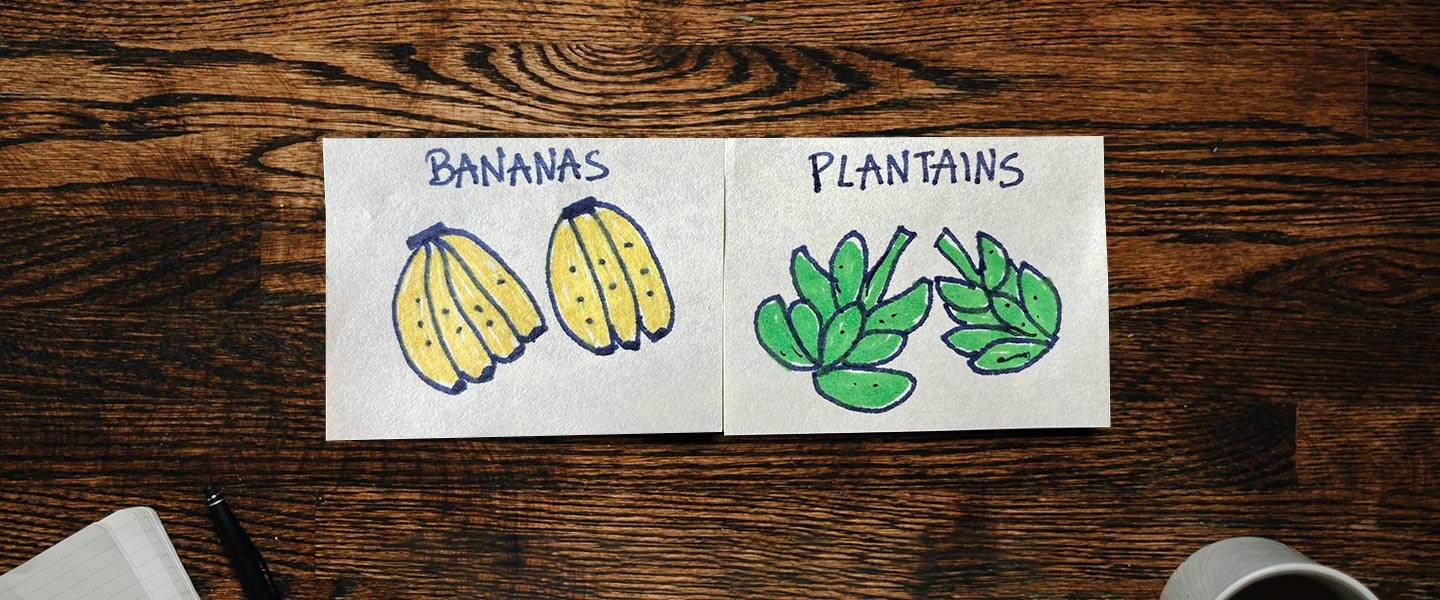Cupcakes and muffins, weather and climate, turtles and tortoises, bananas and plantains… are only a few examples of the many things in the world that appear similar, but are actually different.
Let’s take a closer look at one of these examples: bananas and plantains. At the grocery store, they might all look like bananas. However, each type of banana is unique in color and taste, and serves different purposes. Bananas are often thought of as yellow, sweet fruit. Plantains, on the other hand, are different from dessert bananas (the yellow ones). Plantains are tougher on the outside, more starchy, and usually require cooking. They are both bananas, but you use them differently.
The same thing is true of the methods in the LUMA System. At first glance, some design methods appear to be very similar; however, when you look more closely, you realize they serve distinct purposes. (Sometimes we call these lookalikes “doppelgängers.”)
In this post, we examine eight sets of methods that fit this paradigm and offer hints to help you distinguish between them. Our hope is to help you decide which method to use to achieve your objective when practicing human-centered design.
What’s on Your Radar vs Bull’s-eye Diagramming
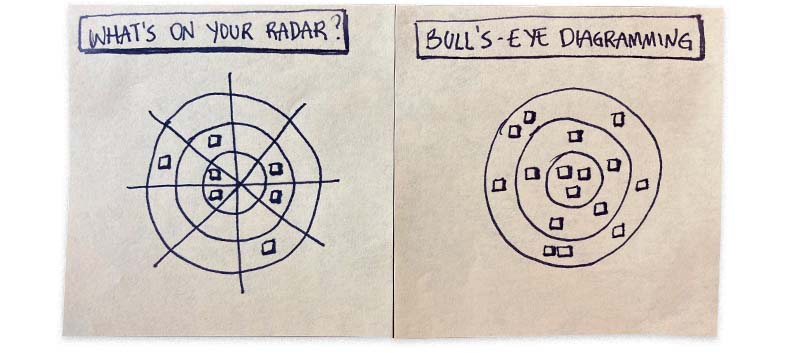
- Lives in the Looking skill set for observing the human experience.
- Great for organizing items based on personal significance.
- Uses individual thoughts as inputs.
- It’s divergent in nature.
- Lives in the Understanding skill set for analyzing challenges and opportunities.
- Great for prioritizing a set of tasks, features, or ideas as a team.
- Uses data points as inputs.
- It’s convergent in nature.
Build Your Own vs Rough & Ready Prototyping
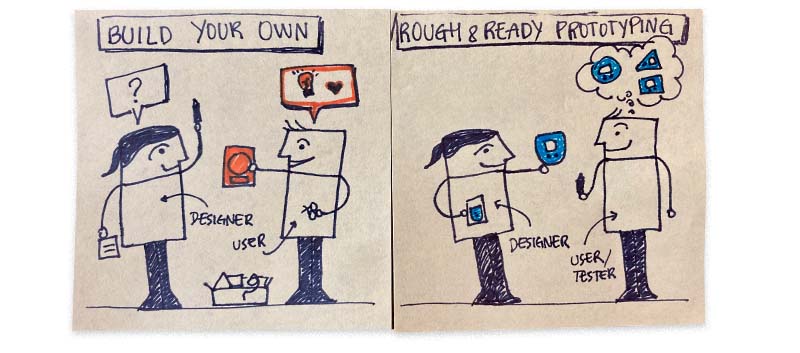
- Lives in the Looking skill set for observing the human experience.
- An activity where people create an artifact representing an ideal solution from their perspective.
- Helps people express what they want and desire as a reference or expectation of your team’s ultimate solution.
- Uncovers latent and unmet needs.
- Lives in the Making skill set for envisioning future possibilities.
- A rough model of a new idea that approximates its appearance and behavior.
- Helps you create something tangible for people to interact with and give you feedback.
- Helps you identify what’s working, and uncover weaknesses early in the process.
Critique vs Rose, Thorn, Bud
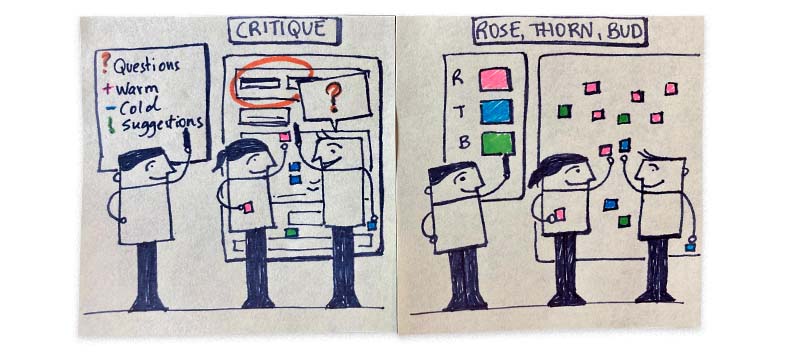
- Lives in the Looking skill set for observing the human experience.
- Great for asking clarifying questions, and giving and receiving constructive feedback.
- Provides a structure for productive discussion about positive and negative aspects of the project, and for sharing suggestions for improvement.
- Reveals blind spots in your design activities.
- Lives in the Understanding skill set for analyzing challenges and opportunities.
- Great for documenting observations, opinions or data as positive (roses/pink), negative. (thorns/blue), or having potential (buds/green).
- Provides a way to analyze a set of data, and identify issues and opportunities.
- Helps you scope a problem by revealing areas of focus.
Stakeholder Mapping vs Concept Mapping
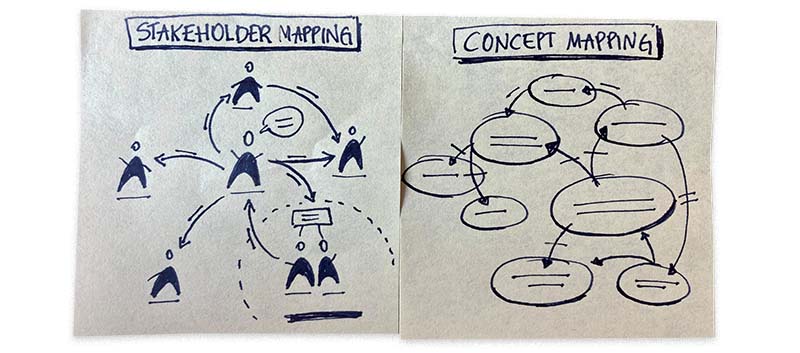
- Lives in the Understanding skill set for analyzing challenges and opportunities.
- Illustrates the relationships of the entire landscape of people in a given system, their relationships, interactions, and needs.
- Focuses on people above other factors.
- Helps your team understand the extent and impact of your design decisions.
- Also lives in the Understanding skill set.
- Illustrates the relationships between various concepts (nouns) and relational links (verbs) in a given subject area.
- Focuses on the various people, places, and things associated with a solution.
- Helps your team obtain clarity, deeper knowledge, and shared comprehension within a subject area.
Experience Diagramming vs Schematic Diagramming
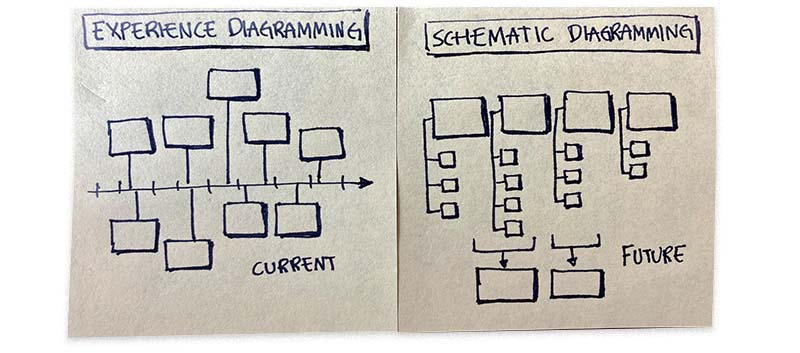
- Lives in the Understanding skill set for analyzing challenges and opportunities.
- A diagram that shows a person’s current experience.
- Helps you consider the impact of each and every element of an experience.
- Deepens your empathy for others by bringing to light complexities, difficulties, and struggles people face.
- Lives in the Making skill set for envisioning future possibilities.
- A diagram that shows the structure of a proposed future experience.
- Helps you work out functional details.
- Allows your team to collaborate on how the idea will work as a functional system, from structuring screen layouts, to sequencing steps in a service experience.
Problem Tree Analysis vs Abstraction Laddering
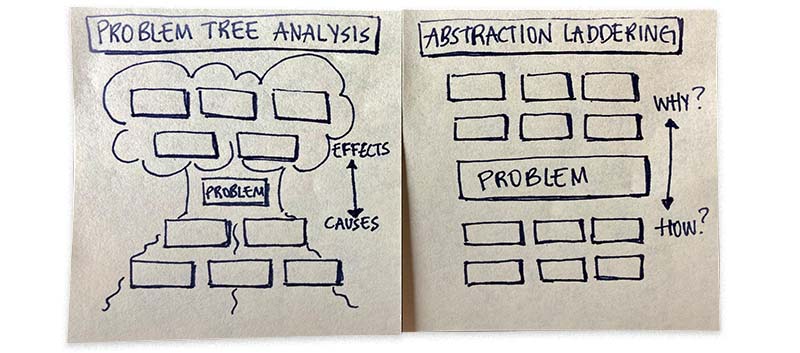
- Lives in the Understanding skill set for analyzing challenges and opportunities.
- Great for exploring causes and effects of a problem.
- Helps you untangle a complex problem.
- Provides a tree-like structure for your team to reveal concerns and recognize the root of a problem and its branching symptoms.
- Also lives in the Understanding skillset.
- Great for broadening or narrowing the scope of a problem.
- Helps you refocus a problem statement.
- Provides a ladder-like structure for your team to expand the scope of your inquiry by moving up the ladder and asking Why?, or narrowing the scope by moving down the ladder and asking How?
Thumbnail Sketching vs Storyboarding
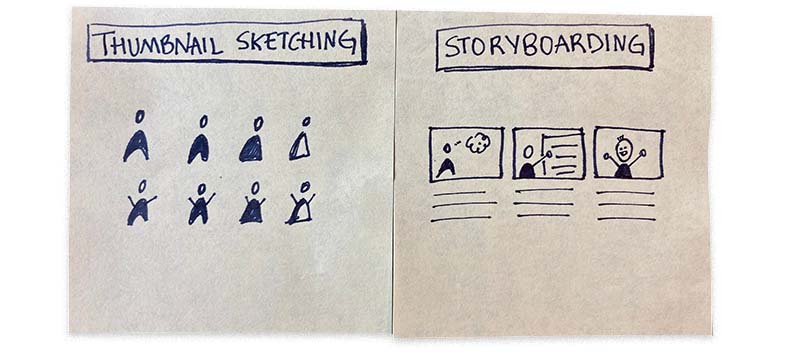
- Lives in the Making skill set for envisioning future possibilities.
- A series of small drawings used to quickly generate a number of ideas.
- Helps you externalize your ideas quickly and make iterative improvements.
- Encourages you to explore and share many different ideas visually.
- Also lives in the Making skill set.
- A series of connected images illustrating key elements of a new scenario.
- Helps your team visualize people experiencing your new idea in action.
- Encourages your team to visually organize and communicate ideas more clearly.
Concept Poster vs Cover Story Mock-up
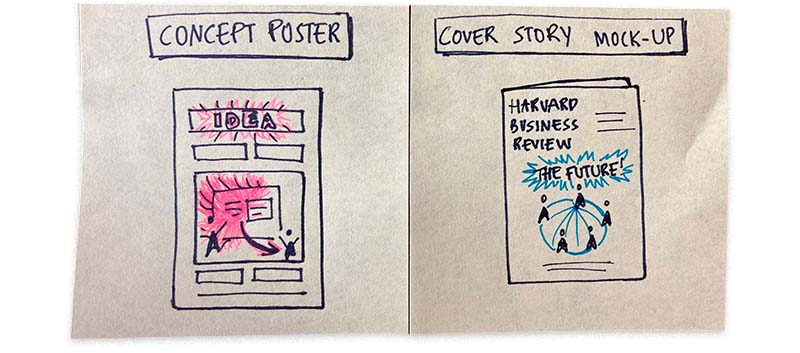
- Lives in the Making skill set for envisioning future possibilities.
- A visual poster presentation format of the main points of an idea.
- Great way to promote your idea, build a business case, and get support for development.
- Provides your team with a roadmap for moving forward.
- Also lives in the Making skill set.
- A news article presentation format describing the successful future of an idea.
- Great way to build excitement around a successful future state for your idea and get buy-in.
- Inspires your team and promotes a shared vision.
Conclusion
I hope these comparisons clarify the purpose of each method in these 8 sets of “doppelgangers” and help you plan your next human-centered design activity.
The key to figuring out a method’s purpose is knowing where it’s located in the LUMA System. First, determine if the method is related to Looking, Understanding, or Making, then find the appropriate subcategory. Each subcategory is clustered by purpose (what the methods help you do). That’s all there is to it!
To learn more about each method, including examples, recipes, tips and advice, and resources, I recommend visiting LUMA Workplace.
Happy facilitating!

